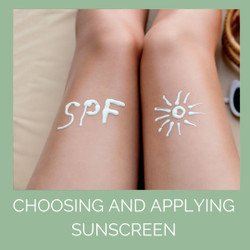Sunscreen is only as good as how it’s applied. Too little and coverage is affected. Not rubbed in enough and it won’t offer adequate protection.
It’s vital to know how to apply your sunscreen properly, to truly protect you and your children’s skin from sun damage.
As natural sunscreen formulators, we’re passionate about making sure you know how to use your products safely and effectively, so here is our expert guide:
Firstly, how to choose a great sunscreen
1. Look for broad spectrum protection:
The sun’s UVB rays can burn our skin and its UVA rays accelerate oxidation and aging in all weathers.
For this reason, it’s important to use the best sun cream you can, which will include having a broad spectrum SPF (sun protection factor). This means it includes protection from both UVA and UVB rays.
UVB rays are the main cause of skin cancer, and all sunscreens protect against them. They will prevent sunburn, but if a product is not broad spectrum, it doesn’t protect against UVA rays.
UVA rays also cause cancer but also cause much of our skin’s premature ageing, so it’s important to choose both.
Ideally choose a sunscreen that also has antioxidants, but make sure you’re getting a good top-up source of antioxidants through a moisturiser as well.
SPFs must pass rigorous testing to be called “broad spectrum.” Products that aren’t broad spectrum must carry a warning that they only protect against sunburn, not skin cancer or skin aging.
2. Consider the texture of the cream:
Some people like a heavier sunscreen, especially if you’re going to a hot country where the sun’s rays are stronger.
This can make you feel even hotter though, so if you’re out and about, or for your face you may prefer a milk or gel texture.
3. Go for SPF30+
Your sunscreen should offer sun protection factor (SPF) 30 or higher. The SPF number is the level of protection the sunscreen provides against UVB rays.
Higher SPF numbers do mean more protection, but the higher you go, the smaller the difference becomes.
How much Protection Can I Expect from My Sun Screen?
- SPF 15 sunscreens filter out about 93% of UVB rays
- SPF 30 sunscreens filter out about 97%
- SPF 50 sunscreens about 98%, and SPF 100 about 99%
No sunscreen protects you completely.
How to Apply Sunscreen
Moisturise first
Apply your antioxidant (face and body) moisturiser first, then your sun cream on top.
Sunscreen tends to be richer, so you’ll get better absorption of your daily moisturiser this way. This principle also applies when wearing makeup (makeup will go on top).
By applying moisturiser first, you also get a more even coverage, particularly if you have dry skin.
Make sure to rub the product in thoroughly – simply wiping it over the skin isn’t enough.
Don’t skimp!
Don’t skimp on sun screen, either! Apply enough to get an even coverage otherwise you will reduce the SPF of your cream. For one arm and shoulder for example, use the rule of a thumb – two fingers worth of sun cream should be enough.
One of the great benefits of natural sun screen (one that uses zinc oxide and or titanium dioxide only) is that you can go straight out into the sun after you’ve applied it. The minerals provide a physical shield immediately and there’s no need to wait for the chemicals to work like you have to with a synthetic sun screen.
Re-apply:
For best results, reapply sunscreen at least every 2 hours and even more often if you are swimming or sweating.
Re-apply your sunscreen every time you swim, shower or towel yourself dry.
For how frequently to apply sunscreen, check out our guide to understanding SPF, but as a rule of thumb, an SPF 15 gives you 2.5 hours of protection and an SPF 30 gives you 5 hours.
On hot days, if you’re wet or if you’re very fair, half this.
Remember a couple of key facts:
“Water resistant” does not mean “waterproof”. No matter what the product says, if you’re in water, it will affect the effectiveness of your sunscreen, as will sweat.
It is VITAL to use a separate sunscreen to your makeup. When absorbed, an SPF of 30 in tinted moisturiser can reduce to around SPF10 – 15.
Other ways to stay sun-safe
In addition to choosing the right sunscreen and using it correctly, follow these steps to keep yourself and your family protected against cancer and sun damage.
- Cover up. Cool clothing, and a wide-brimmed hat help protect as much skin as possible. Protect your eyes with sunglasses that block at least 99 percent of UV light
- Seek shade. Limit your direct exposure to the sun, especially between the hours of 10 a.m. and 4 p.m., when UV rays are strongest. If you’re at the beach for the day, have a UVB blocking tent handy for shade, use umbrellas and t-shirts to cover up in
- Don’t use oils to ‘tan’. You will end up burning your skin terribly and it simply isn’t worth it
More Advice?
If you’d like any more advice on caring for your skin, please do email us – customercare@odylique.co.uk, add your question as a comment below, or call 01638 491022 – we’re here to help! Browse our range of summer skincare now.



